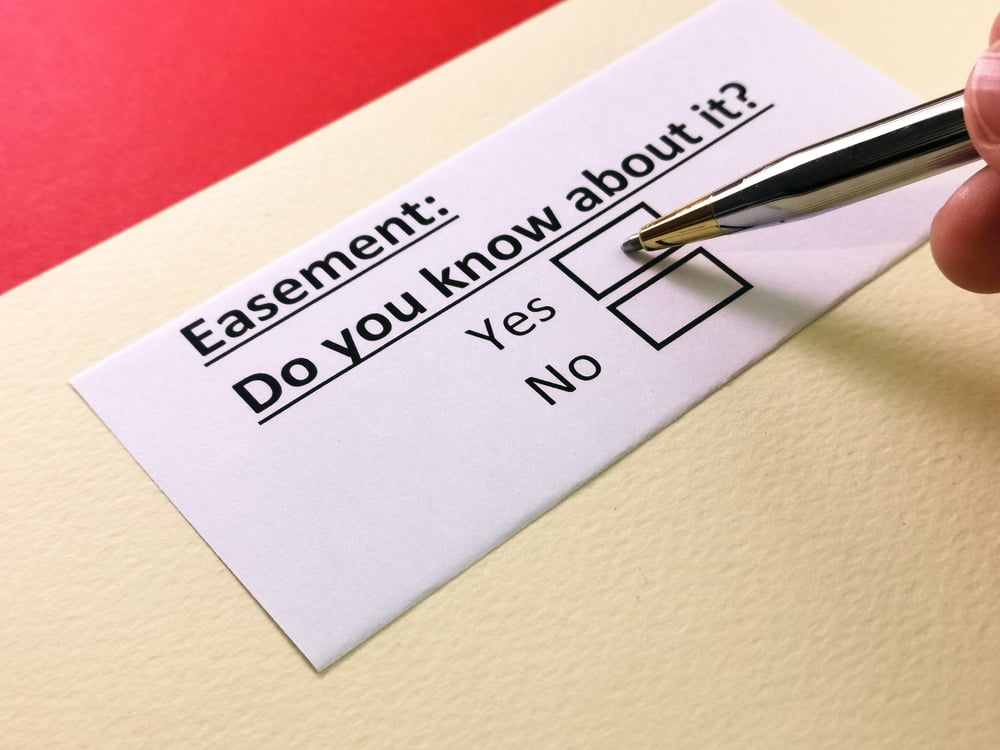Imagine that you’re in the process of buying a new home. As a former renter, you’re excited to gain all sorts of property rights that you’ve never had before. However, the title search reveals that the property has an easement on it. Your excitement comes to a screeching halt.
You might be wondering, “what is an easement?” In short, an easement gives a third party the right to use your property without your permission. Don’t worry; it’s not as bad as it sounds, and there are limited scenarios in which an easement is created. If you’re thinking about buying a house, it’s good to know what an easement is and how having an easement on your property might affect you.
What Is An Easement?
An easement gives a third party the right to use or access a property they do not own, but only for a specific purpose. The third party could be an individual, a company, or a government entity, and they must adhere to strict guidelines set by the easement.
The easement definition might sound alarming at first, but it won’t threaten your property ownership in any way. For example, a common scenario is having a power line on your property, which your local power company will need to access.
It’s also possible for you to hold an easement as an individual. For example, let’s say you need to cross your neighbor’s lawn to access your home. In this case, having the easement is necessary.
Easements are designed to benefit neighborhoods and residents. In the previous example of the power company, there might come a day when you’re grateful that a representative can come onto your property without permission. If a power line comes down in your yard, you’ll be relieved that they can address the hazard quickly without having to get legal permission to access your property.
How Do Easements Work?
Easements are commonly established when a property owner grants permission to a third party to use their land. The agreement should be designated in a legal document such as a deed. In some cases, the third party might compensate the property owner for the inconvenience. However, subsequent property owners should not expect to be compensated. The length of the easement is typically determined by its type. We’ll describe several common types next.
[ Thinking about investing in real estate? Register to attend a FREE online real estate class and learn how to get started investing in real estate. ]

Types Of Easements
There are several types of easements that can be placed on your property. As a homeowner, you’ll want to understand how each type might affect you. Here are the four common types you might run into:
-
Easement In Gross & Utility Easement
-
Private Easement
-
Prescriptive Easement
-
Easement By Necessity
Easement In Gross & Utility Easement
Local and state governments can issue utility easements, which give utility companies the right to access infrastructure on private properties. This is the most common type of easement, as it’s not unusual to find utilities on a property, such as water lines, electricity, and sewer systems.
The utility company in question won’t have free reign to do whatever they want, but they will have the power to do what’s good for the neighborhood. The easement can also put limits on what you can do to your property. For example, the easement could prevent you from planting a tree that would interfere with a power line.
Utility easements are nested under the “easement in gross” category, which only applies to one property and grants access to a specific entity.
Private Easement
A private easement is made between a property owner and a third party. For example, let’s say you are fortunate enough to have a path to a private beach on your property. Your neighbor needs to access that path to install fencing on their own beachfront.
You could strike an agreement and sell a private easement to your neighbor. However, keep in mind that private easements can affect subsequent homeowners. That’s why it’s always a good idea to check for easements by running a title search before buying a home. If you don’t like the terms of an existing easement, it could be a dealbreaker.
Prescriptive Easement
If you feel like someone is trespassing, act quickly. For example, let’s say that your neighbor built a fence around the perimeter of their yard five years ago, but it’s technically on your property. They did so without your permission, and it’s been a point of contention and hostility.
You may have verbally asked them to remedy the situation several times. They never complied, and you never took legal action. The court could see this as a failure or concession on your part. They could grant your neighbor a prescriptive easement, allowing them to keep the existing fence despite not being the rightful property owner.
Easement By Necessity
An easement by necessity is created when someone is forced to access your property, and there are no other options. A typical example is when a neighbor is landlocked, and they can only get to their home by accessing a road on your property. In this case, the easement is created out of necessity.
As an owner, you don’t have the right to remove this type of easement. Furthermore, doing so would be a burden to your neighbor, as they’d have no way to access the main road.
Prescriptive Easement Vs. Adverse Possession
A prescriptive easement and an adverse possession are directives that give someone the right to access your property through open and notorious use. However, there are distinctions between the two.
An adverse possession typically takes place when trespassing has occurred over a long period. It’s referred to as a negative easement. The time frame is around 10 to 20 years, but be sure to check with the laws in your state. In contrast, a prescriptive easement applies to specific and limited situations.
The best way to differentiate between a prescriptive easement vs. adverse possession is the intent or actions of the individual. In the case of a prescriptive easement, the non-owner is using your property in a limited capacity. In the example above, they built a fence that was technically on your side of the property. In adverse possession, the non-owner intends to take over the property in full.
How Does An Easement Affect My Property?
In most cases, an easement won’t affect your actual ownership of your property. Instead, it will only limit you from blocking the easement holder’s use of your property within set guidelines. In most cases, an easement is placed to benefit you and your neighbors. For example, you want your utility provider to be able to access and maintain the water lines that are on your property.
At most, an easement will merely be cause for annoyance but not an excessive burden. It helps establish permission and accessibility between you and a third party, to help avoid any contention. If you’re ever in doubt, don’t hesitate to take legal action. Otherwise, you could end up with a prescriptive or negative easement on your hands.

How To Find If A Property Has An Easement
It should now be pretty clear as to why you’ll want to find out if a property has an easement on it before you buy it. An easement could be of no trouble or annoyance at all, while others might be burdensome. At the end of the day, it depends on your perception. If you’re a private person, having a third party access your property in any capacity could be a deal-breaker. On the other hand, perhaps your mindset is more communal, and it wouldn’t bother you at all.
To find out if a property has an easement, consult the following:
-
County records office
-
City hall
-
Local utility providers
-
Property survey
-
Title search
What Is An Easement Appurtenant?
A public beach serves as a great example to help explain what an easement appurtenant is. Let’s say that you own a vacation property in Florida, which sits on a public beach. There’s a private pathway on your property that is the only way to access the beach in the neighborhood.
This is a likely scenario in which an easement appurtenant would be applied. It would give other residents in your neighborhood the right to come onto your property to access the beach. In this case, the beach is the dominant tenement, and your property is the servient tenement. Therefore, the beach is the parcel of land that benefits from the easement appurtenant.
How To Remove An Easement From Your Property
If there is an easement on your property, the first step is to check if it has a termination date. Next, check to see if it was placed based on a circumstance that no longer applies. It could be that the easement is no longer valid based on one or both of these two items. You should also measure how much time has passed since the easement holder last accessed your property. The easement could be considered abandoned if they’ve failed to use it.
If it turns out that the easement is still valid, you could request to have it removed. You might ask the easement holder to relinquish their rights. If they agree, they’ll need to make it a public record by submitting a quitclaim deed.
Another avenue is to take the matter to the courts. If the court finds that the easement holder abuses their rights, they may grant your request to remove the easement. However, if the easement is valid and the non-owner has remained within their rights, the probability of successfully removing it is much lower.
Summary
You’re about to close on a house, and you’re so excited. As you’re getting ready to sign the deal, the title search comes back and shows that there’s an easement on your house. “What is an easement,” you think to yourself. All of a sudden, the excitement has turned into anxiety. Before you get upset, take the time to understand what type of easement is placed on your home and what the implications are. If you’re lucky, it could be as simple as allowing your local power company to go into your yard to maintain the power line on occasion. If you’re unlucky, it could be something as burdensome as allowing your neighbor to park in your driveway. Depending on the nature of the particular easement, it could be of no concern, or it could even be a dealbreaker. Not everyone will encounter an easement, yet they’re not uncommon. That’s why you should always run a property survey and title search to find out whether or not an easement exists.
What kind of easement do you think you could look past, and which type would be a dealbreaker? Have you ever experienced an easement before, and what was it like? Let us know in the comments below!
Ready to start taking advantage of the current opportunities in the real estate market?
Click the banner below to take a 90-minute online training class and get started learning how to invest in today’s real estate market!


